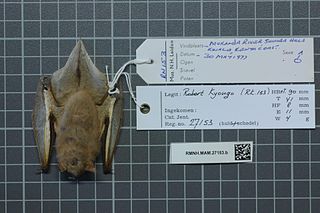
Vespertilionidae is a family of microbats, of the order Chiroptera, flying, insect-eating mammals variously described as the common, vesper, or simple nosed bats. The vespertilionid family is the most diverse and widely distributed of bat families, specialised in many forms to occupy a range of habitats and ecological circumstances, and it is frequently observed or the subject of research. The facial features of the species are often simple, as they mainly rely on vocally emitted echolocation. The tails of the species are enclosed by the lower flight membranes between the legs. Over 300 species are distributed all over the world, on every continent except Antarctica. It owes its name to the genus Vespertilio, which takes its name from a word for bat, vespertilio, derived from the Latin term vesper meaning 'evening'; they are termed "evening bats" and were once referred to as "evening birds".
Bobrinski's serotine is a species of vesper bat. It can be found in Iran and Kazakhstan.
The western false pipistrelle, species Falsistrellus mackenziei, is a vespertilionid bat that occurs in Southwest Australia. The population is declining due to loss of its habitat, old growth in tall eucalypt forest which has largely been clear felled for tree plantations, wheat cultivation and urbanisation. Although it is one of the largest Australian bats of the family, the species was not recorded or described until the early 1960s. A darkly colored bat with reddish brown fur and prominent ears, they fly rapidly around the upper canopy of trees in pursuit of flying insects.

The pungent pipistrelle is a species of vesper bat in the family Vespertilionidae. It is found in Indonesia and possibly the Philippines.

The Peters's pipistrelle is a species of vesper bat in the family Vespertilionidae. It is found in Indonesia, Malaysia, and the Philippines.
The eastern false pipistrelle is a vespertilionid bat that occurs in eastern and south-eastern Australia, including the island of Tasmania.

The Arabian pipistrelle is a species of vesper bat in the family Vespertilionidae. It is found only in Iran and Oman.

Cadorna's pipistrelle is a species of vesper bat in the family Vespertilionidae. It is found in India, Laos, Myanmar, Thailand, and Vietnam.

The big-eared pipistrelle is a species of vesper bat in the family Vespertilionidae. It can be found in Indonesia and Malaysia. It forages over mud flats over Peninsula Malaysia but its roosting activities are unknown. Its habitat is being threatened by deforestation for agriculture, plantations, logging and fires but how it affects this bat or if it is adaptable are unknown.
Falsistrellus is a genus of vespertilionid family of bats, small predatory flying mammals. They are known from Australia. The poorly researched species have been variously placed by authors, and revised again by studies of their distinct characteristics, consequently the falsistrelles may also be referred to as pipistrelles or false pipstrelles.
The lenis woolly bat is a species of bat in the family Vespertilionidae. It is found in South and Southeast Asia.

The genus Hypsugo contains many bats referred to as pipistrelles or pipistrelle bats. They belong to the family Vespertilionidae or vesper bats. They are primarily found throughout Asia, the Middle East, Mediterranean Europe, and North Africa, with a single (debated) species in Sub-Saharan Africa.

Nycticeinops is a genus of vesper bat in the family Vespertilionidae. It contains the following species:
Rosevear's serotine is a species of vesper bat that lives in Guinea and Liberia. It was described as a new species in 2013. It is listed as endangered by the IUCN.
Hypsugo alaschanicus, the Alashanian pipistrelle, is a species of bat in the family Vespertilionidae. It is found in China, South Korea, Mongolia, Japan, and Russia.

Pseudoromicia is a genus of vesper bat in the family Vespertilionidae. All species in this genus are native to sub-Saharan Africa.

Vespertilionini is a tribe of bats in the family Vespertilionidae. The largest of the tribes in Vespertilioninae, it contains many genera found throughout the Old World and Australasia.
Ward's long-eared bat is a species of vesper bat in the family Vespertilionidae. It is found in mountainous regions of South Asia and adjoining regions.











